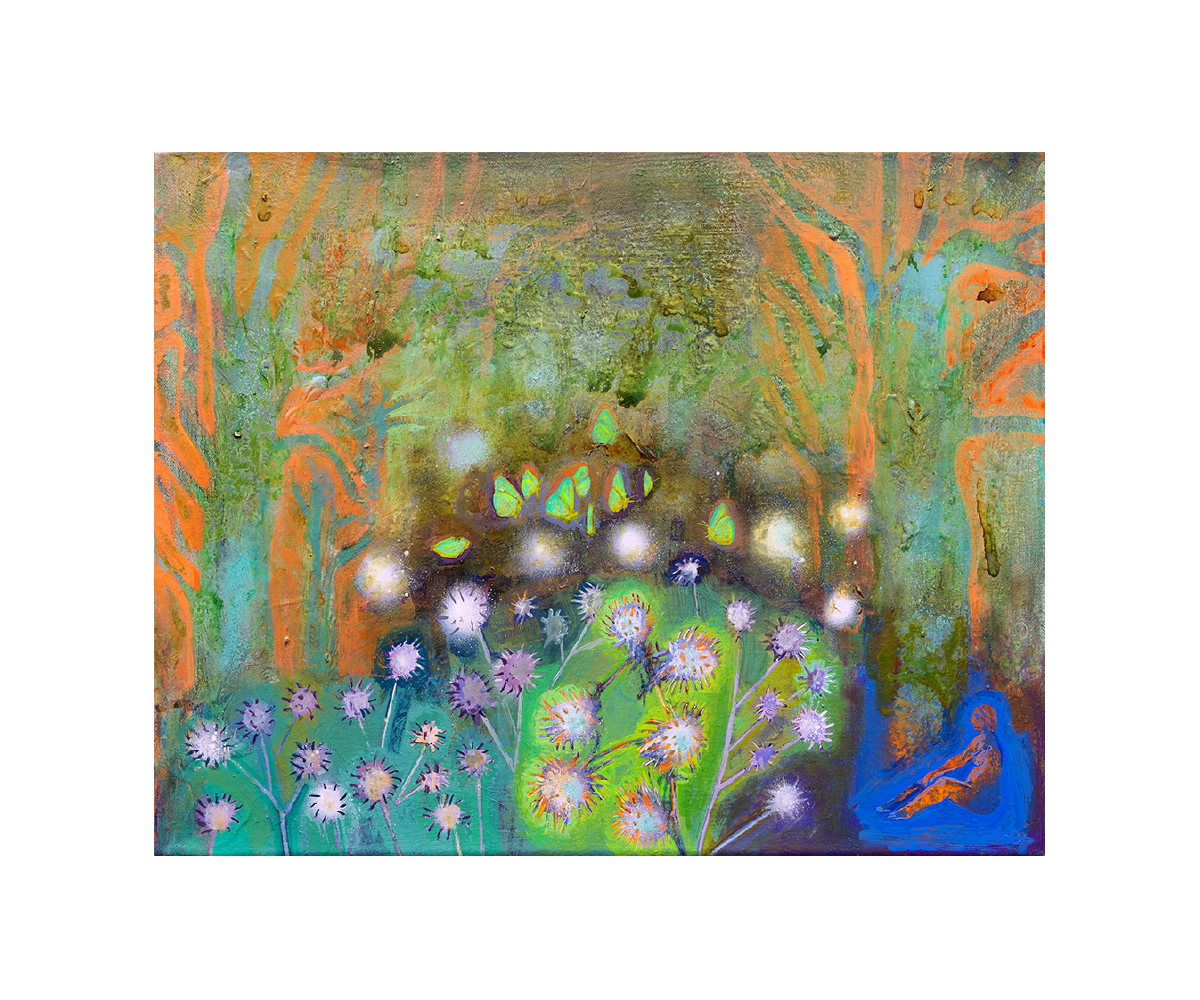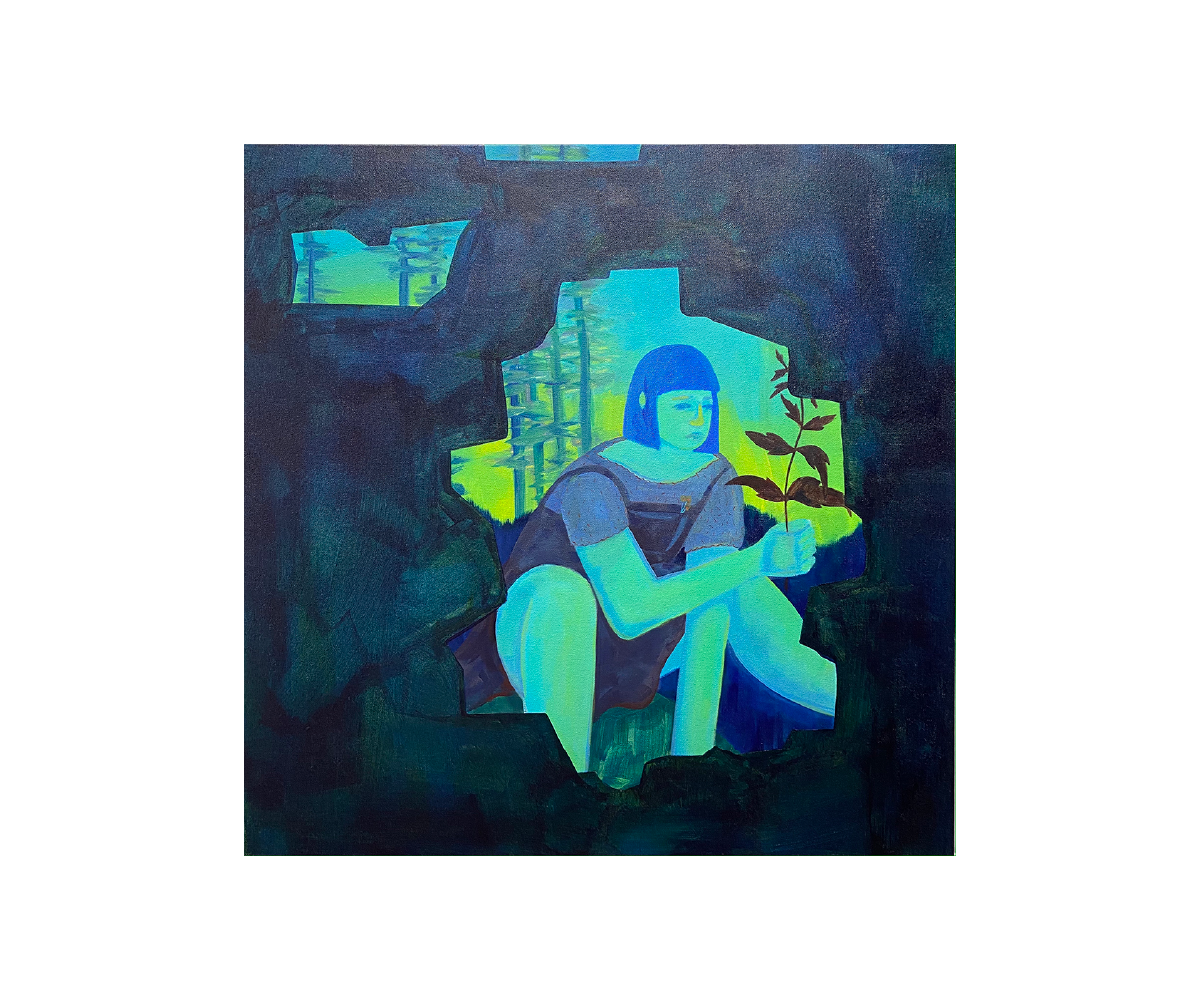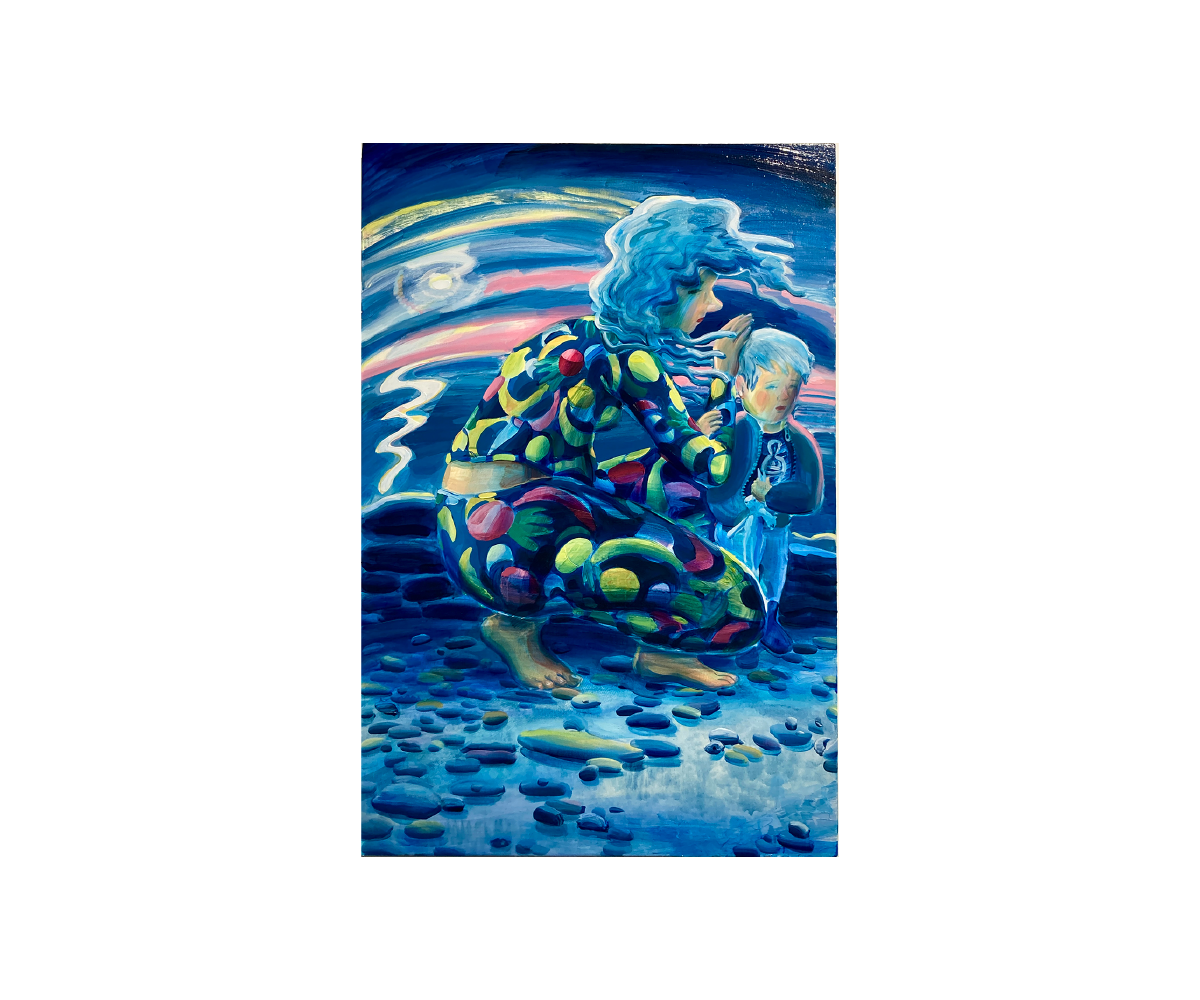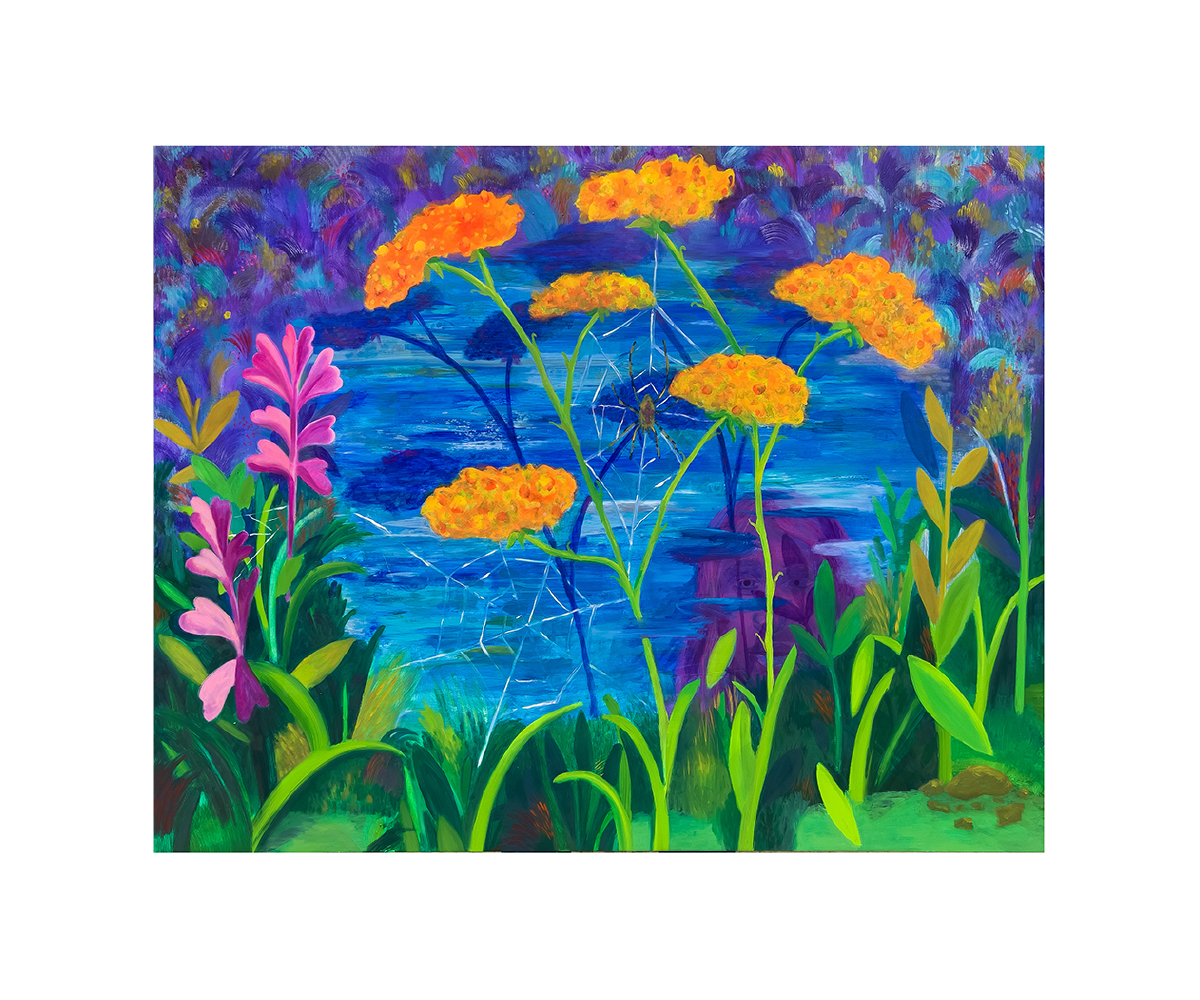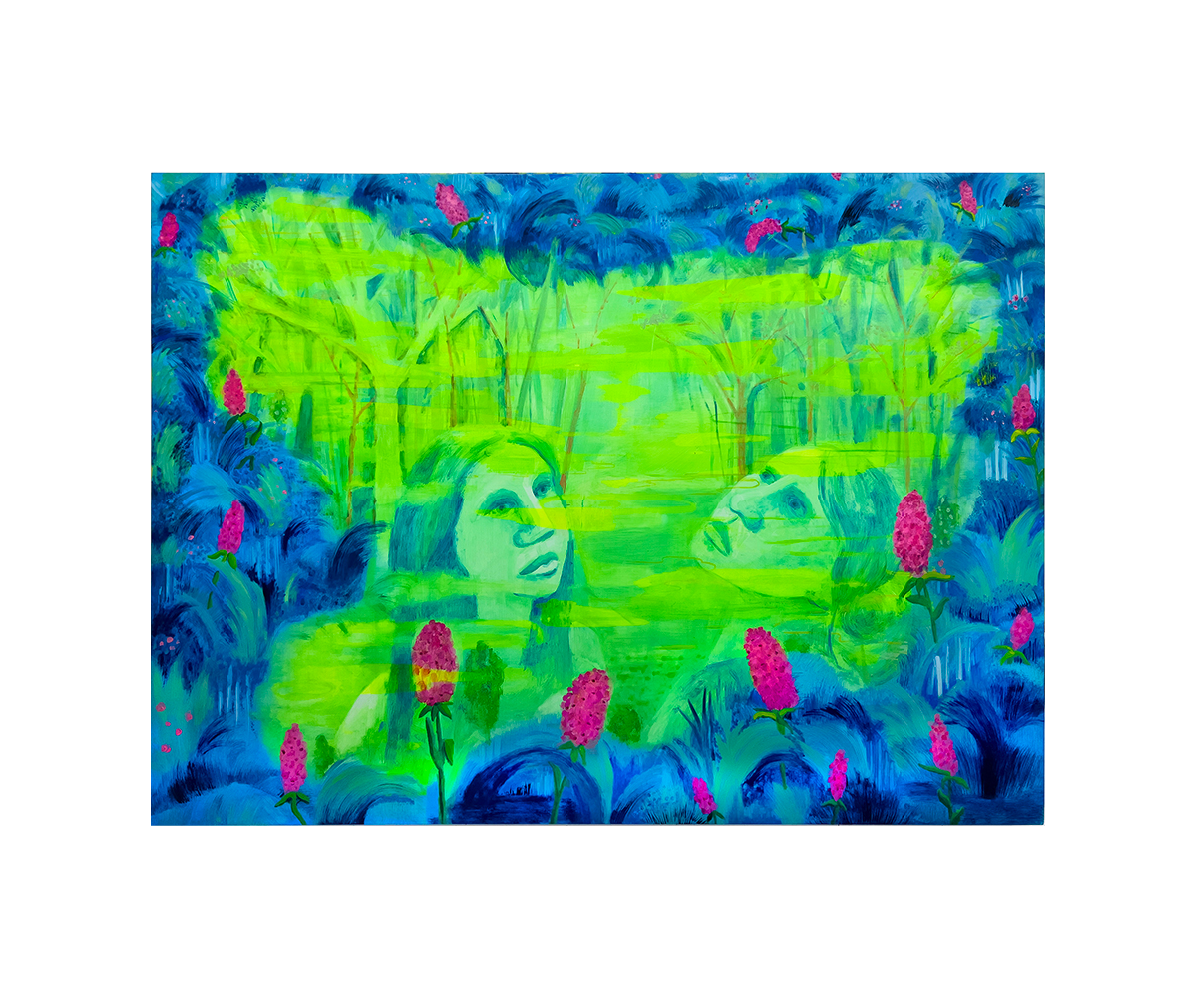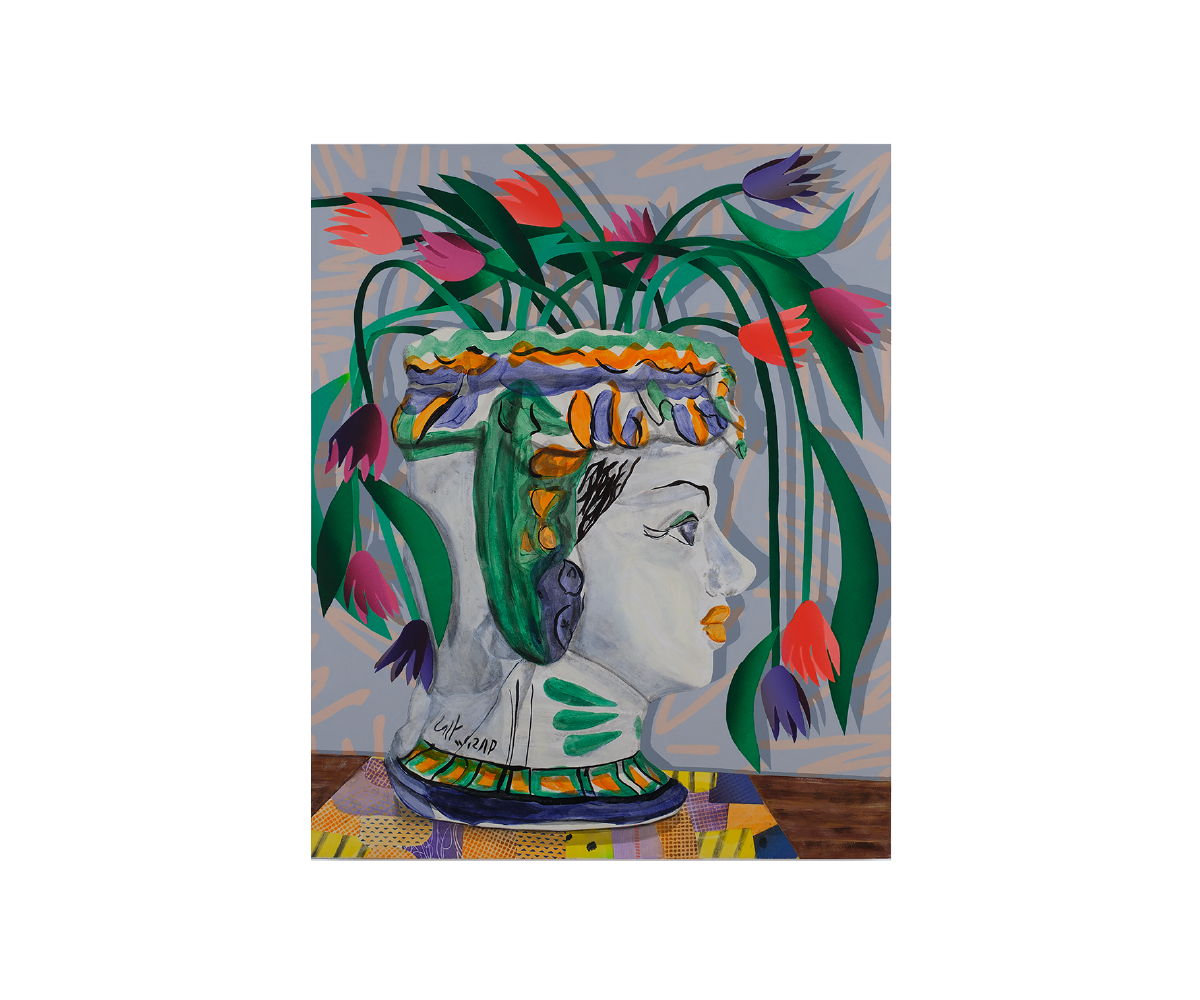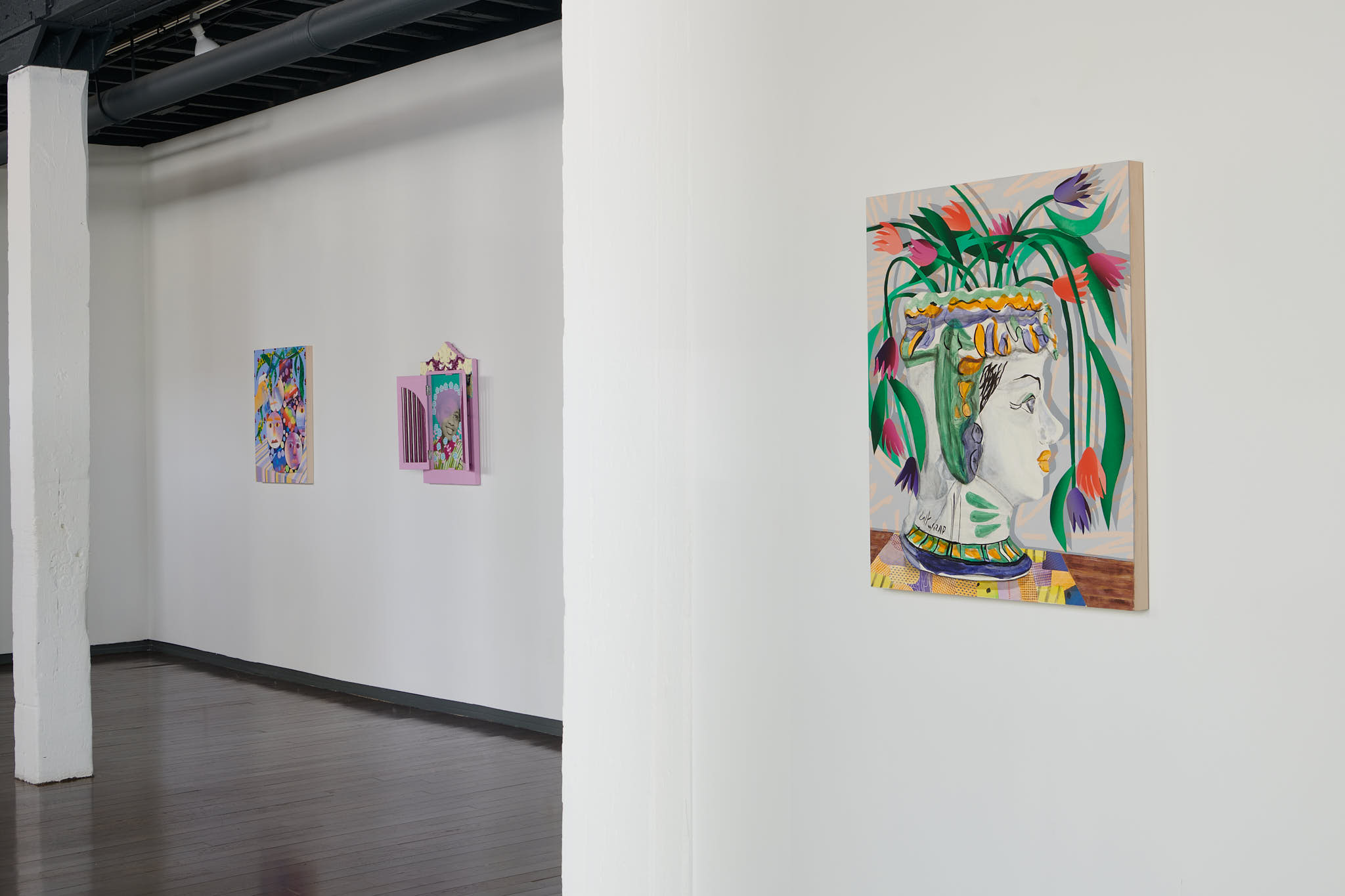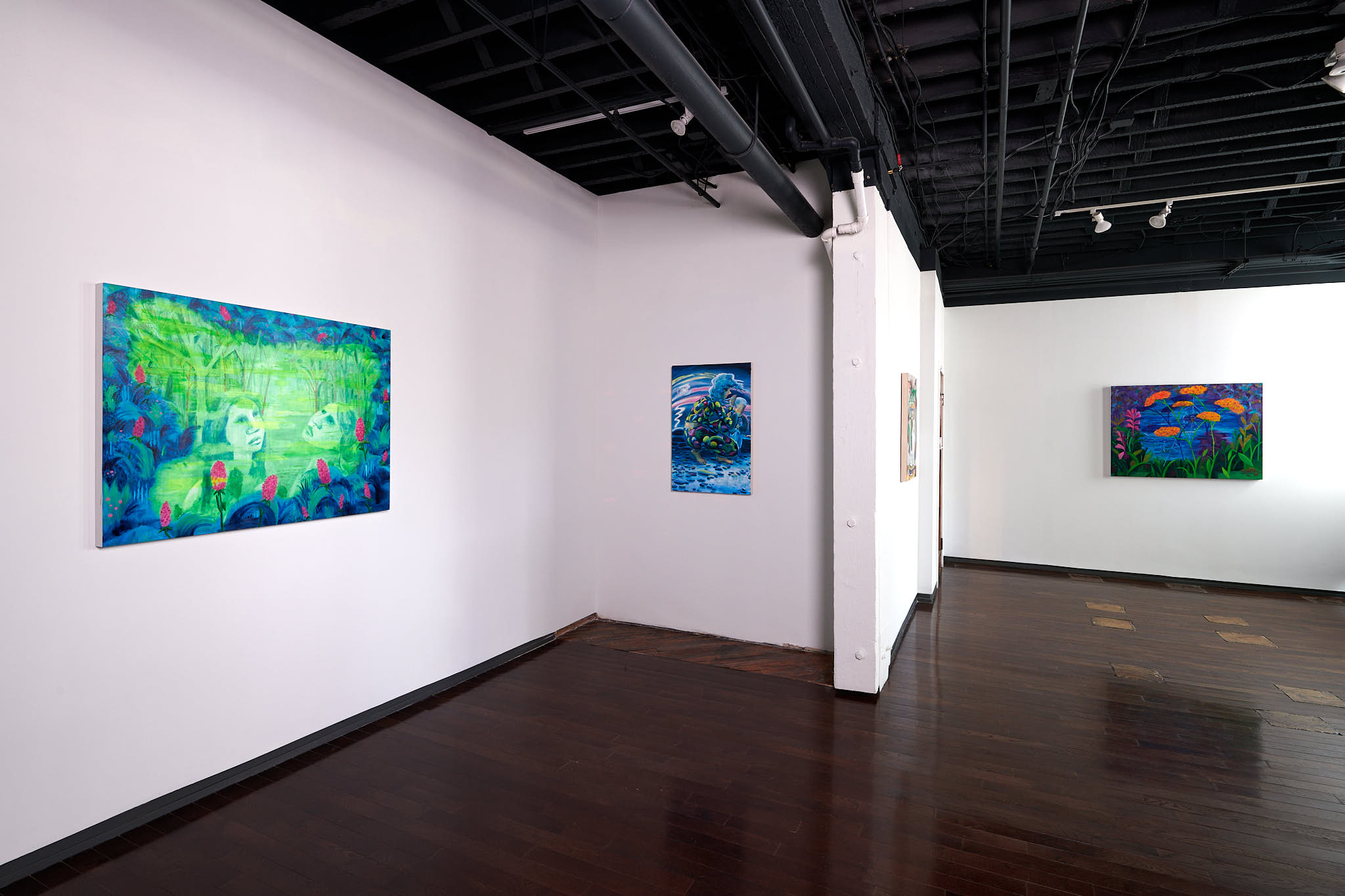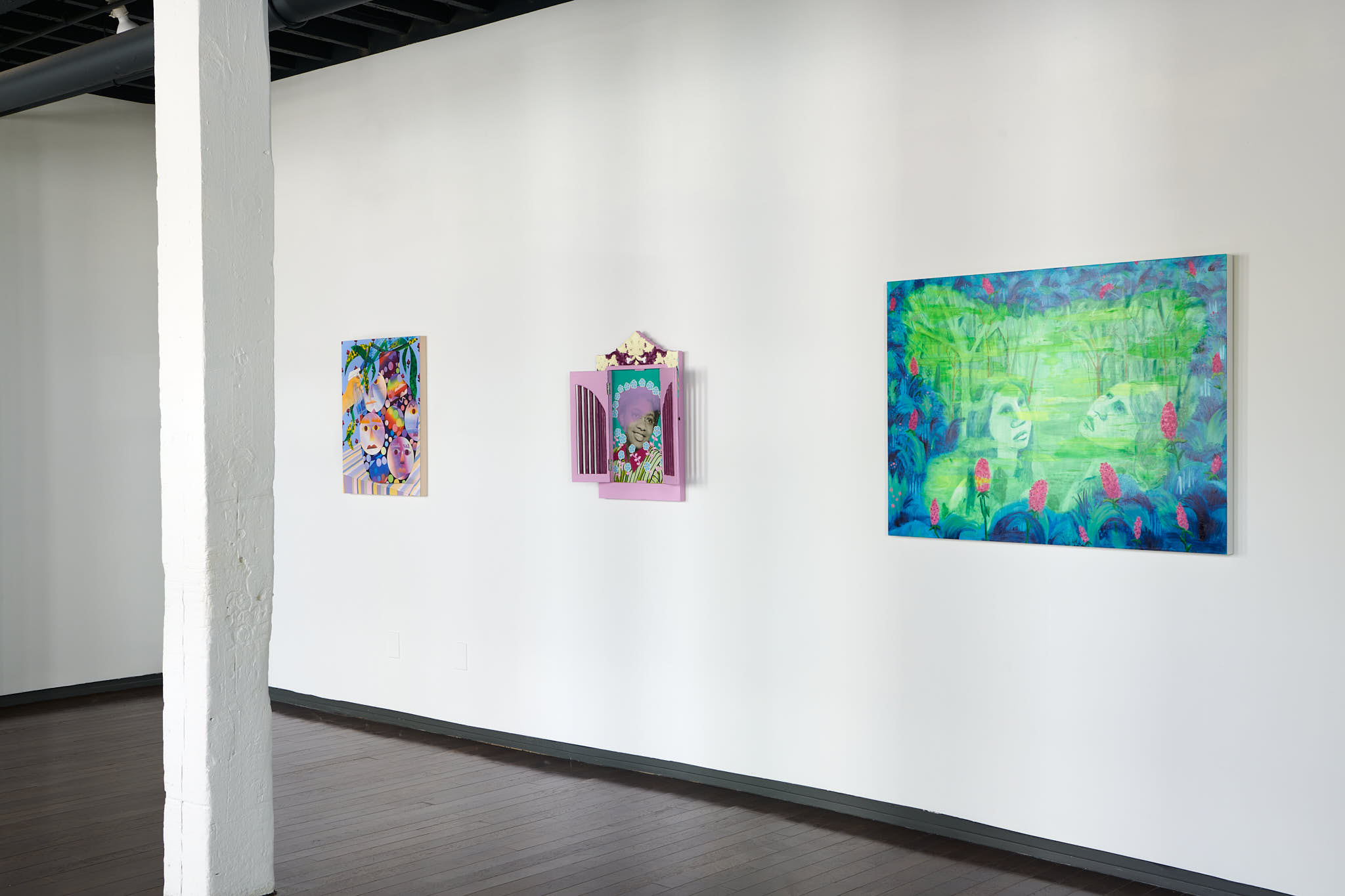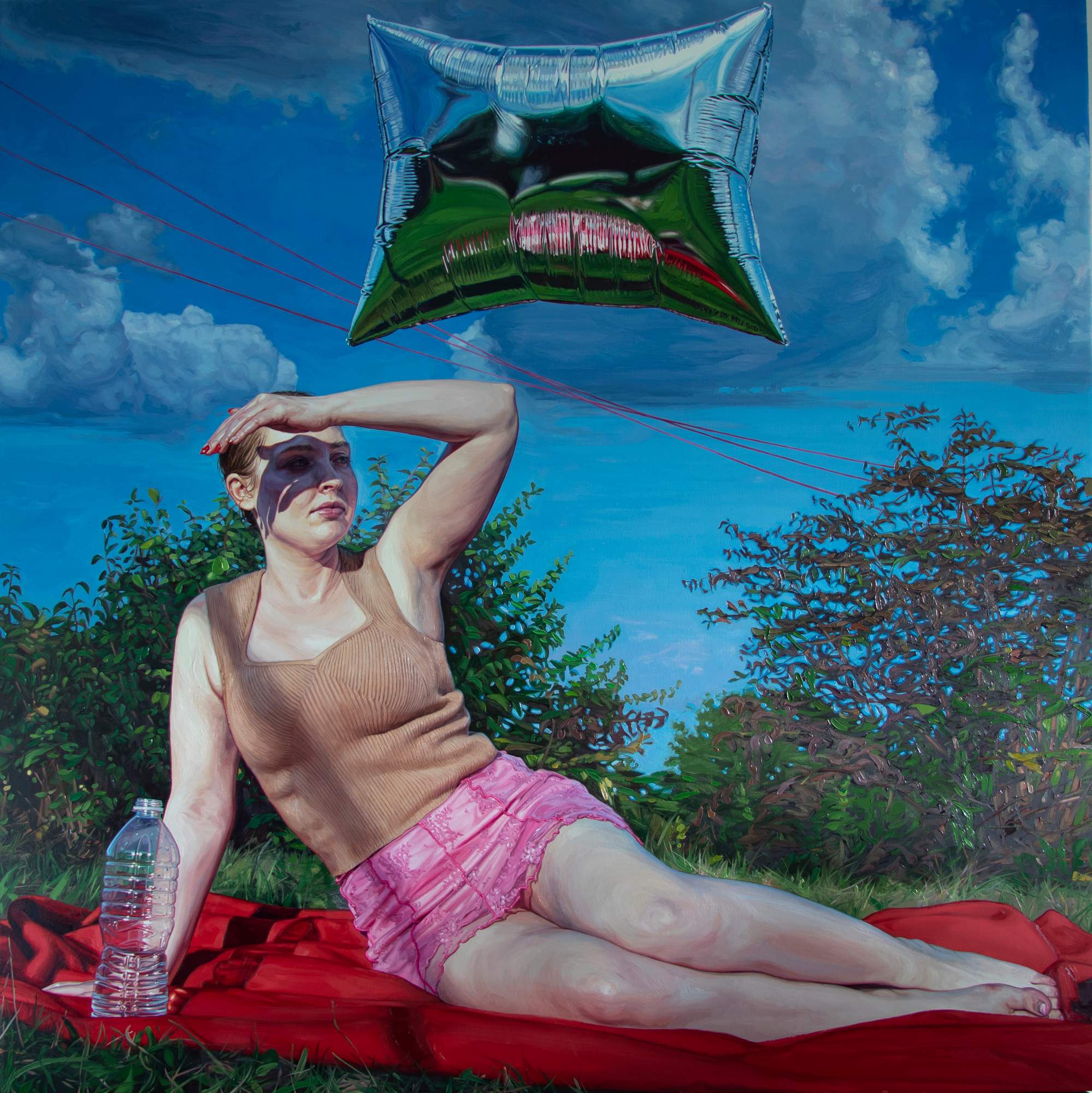
June 22 – July 18, 2023
I Spy a May Queen
Jennifer Coates, Genevieve Cohn, Hilary Doyle, Erika b Hess, Karen Lederer, and Daisy Patton
Curated by Erika b Hess
Contemporary Art Matters is pleased to present I Spy a May Queen, a group exhibition curated by Erika b Hess. The exhibition is on view from June 22 to July 18, 2023, and features the work of Jennifer Coates, Genevieve Cohn, Hilary Doyle, Erika b Hess, Karen Lederer, and Daisy Patton.
Artist Bios
Jennifer Coates is an artist working in Brooklyn, NY and Lakewood, PA. She is the 2021 recipient of the John Koch Art Award from the American Academy of Arts and Letters, a 2021 NYFA Award in painting, a 2019 Fellowship at the Civitella Ranieri Foundation, and a Sharpe Walentas Studio residency (2018-2019). Recent solo shows include Para Pastoral at Pamela Salisbury Gallery, Hudson, NY; Lesser Gods of Lakewood PA at High Noon Gallery, NYC; and Pagan Forest, West Chester University. Recent group shows include Psychedelic Landscape at Eric Firestone Gallery, NYC, Post Pop Landscapes at Acquavella Galleries in NYC and Palm Beach, FL, curated by Todd Bradway. Her work has been written about in Hyperallergic, BOMB Magazine, the Brooklyn Rail, Art Critical, the Huffington Post, Smithsonian Journeys, and Art News, among other publications.
Genevieve Cohn is an artist and educator currently living and working outside of Boston, MA. Genevieve has exhibited work in New York City, Boston, Chicago, and London, among other cities, and is represented by Mindy Solomon Gallery in Miami. Recent exhibitions include a two person exhibition with Garten Gallery in Como, Italy, and solo exhibition with Hashimoto Contemporary in NYC. She has attended residencies at the Fiore Art Center, The Vermont Studio Center, The Ragdale Foundation, and AiRGentum. She is the winning recipient of the Hopper Prize. Her work has been featured in New American Paintings, Create Magazine, Art Maze Magazine. Genevieve teaches painting and drawing at Wellesley College.
Hilary Doyle is an artist, teacher and curator from Worcester, MA. Her work includes painting, drawing, printmaking and sculpture. Doyle recently exhibited at venues such as Taymour Grahne, Hesse Flatow, Public Swim, and Monya Rowe Gallery, and Gallery Func in Shanghai, China. Recent solo shows include Probably a Goddess opening May 2023 at Dinner Gallery in NYC and On the way to the Garden at Taymour Grahne in London in 2022. She has received press coverage in Hyperallergic, Bushwick Daily, and New American Paintings Blog. Doyle teaches at Holy Cross College and taught for years at Rhode Island School of Design, Brown University and Purchase College. She co-founded and teaches for the NYC Crit Club. She was recently gallery co-director at Transmitter gallery and curates shows independently. Doyle received an MFA from Rhode Island School of Design and a BFA from the Massachusetts College of Art and Design. Currently she lives and works in Worcester, MA.
Erika b Hess is an artist and curator. She maintains studios in Columbus, OH, and Long Island City, NY, and is represented by Contemporary Art Matters in Columbus, OH. Hess’s work has been exhibited nationally at venues in New York City, Brooklyn, Detroit, Los Angeles, Boston, and Philadelphia. Her work has been featured in numerous publications. She frequently lectures at colleges such as Wellesley College, Massachusetts College of Art & Design, Ohio State University, and Montana University, among many others. Hess has served on panels such as the Cleveland Institute of Art’s, “Feminism Now: Exposing the Truth,” Boston University’s “Building Collaborative Art Spaces,” and other panels that discuss the overlap between feminism and art. Hess received her MFA from Boston University.
Karen Lederer is an artist based in Brooklyn, NY. She has been an artist in residence at Robert Blackburn Printmaking Workshop, Lower East Side Printshop, and the Sharpe-Walentas Studio Program. Lederer has presented her work in solo exhibitions at Morgan Lehman Gallery, Cheymore Gallery, One River School, Guilford College Art Gallery, Tennis Elbow at The Journal Gallery, Grant Wahlquist Gallery, and Field Projects. She has participated in many group exhibitions, most recently at Morgan Lehman Gallery, Deanna Evans Projects, Dinner Gallery, Cristea Roberts Gallery, and Hashimoto Contemporary. She received her BFA in Printmaking and Drawing from Washington University in St. Louis in 2008 and an MFA in Printmaking from Rhode Island School of Design in 2012.
Daisy Patton is an artist based in Massachusetts. Patton has exhibited in solo and group shows nationally, including a solo at the CU Art Museum at the University of Colorado, the Chautauqua Institution and the Fulginitti Pavilion at the Center for Bioethics at the Anschutz Medical Campus, as well as group shows with MCA Denver, Spring/Break NYC, the Tampa Museum of Art, the Katonah Museum of Art, The Delaware Contemporary, the International Museum of Science and Art, among others. She has paintings held in public and private collections such as the Denver Art Museum, the Tampa Museum of Art, Seattle University, Fidelity Investments Art Collection, and in international airport Hartsfield-Jackson with Delta Airlines, among others.
Patton’s work has been featured in publications such as Hyperallergic, The Jealous Curator, Transition Magazine, The Denver Post, The Chautauquan Daily, The Seattle Met, and more. Minerva Projects Press has published Broken Time Machines: Daisy Patton, a book with essays and poetry on Patton’s practice that debuted spring 2021. Patton has completed artist residencies at Anderson Ranch, the Studios at MASS MoCA, RedLine Denver, Minerva Projects, and Eastside International in Los Angeles. She has been awarded a Massachusetts Cultural Council grant, a Barbara Deming Memorial Fund grant, an Assets for Artists Massachusetts Matched Savings grant, a Montage Travel Award from SMFA for research in Dresden, Germany, as well as longlisted for the Aesthetica Prize 2022. She earned her MFA from The School of the Museum of Fine Arts, Boston/Tufts University, a multi-disciplinary program, and has a BFA in Studio Arts from the University of Oklahoma with minors in History and Art History and an Honors degree. K Contemporary represents Patton in Denver, CO, and Foto Relevance represents her in Houston, TX.
In the exhibition
Installation views
PREFACE
By Rebecca Ibel
By Rebecca Ibel
Welcome to the captivating world of ‘I Spy a May Queen,’ curated by Erika b Hess and proudly presented by Contemporary Art Matters. This exhibition unveils a remarkable series of new paintings by Jennifer Coates, Genevieve Cohn, Hilary Doyle, Karen Lederer, Daisy Patton, and Erika b Hess herself. These artists, united by their sensitive and thoughtful approaches, fearlessly share their narratives, blurring the lines between reality and fiction while embracing the complexities and emotional power of life. The catalog also features ‘ May Queen’ an essay by Laura Sallade whose insightful analysis delves into the rich symbolism and thematic threads that weave throughout the exhibition, providing a deeper understanding of the artistic narratives presented.
Within the realm of painting, there is a rich history of artists who explore non-narrative approaches to expression where objects, colors, and forms converge to unravel profound stories. Symbolist artists from Odilion Redon to Gustav Klimt and Surrealist artists Dorthea Tanning and Leonora Carrington are just a few examples of artists whose work delved into mysticism. As we explore each artist’s work in this group, we find them drawing inspiration from history, mythology and the world around them. Their resulting creations envelop us with vibrant hues and quietly reveal their own truths, leaving an indelible impact.
This project is part of an ongoing series of artist-curated exhibitions in our Columbus gallery. Previously, Dion Johnson’s ‘Flying Colors’ introduced us to a group of California abstract painters whose vivid compositions illuminated our walls in 2021. In 2022, Laura Sanders curated ‘To Die For’ featuring artists who share her passion for painting, embracing landscapes, still life, and figure painting. Now, in 2023, we are thrilled to have Erika b Hess bring together a group of artists who share her fascination with contemporary art that explores mythologies from a modern-day, motherly perspective.
Our introduction to Erika b Hess came through a fortunate encounter a few years ago when she and her family relocated to Columbus from Boston. Bonding over our mutual friend, the esteemed artist Melissa Meyer, we connected instantly. Hess’s dynamic energy knows no bounds, as she balances a thriving studio practice, her role as a mother to three young children, and the success of her podcast, ‘I Like Your Work.’ Her extensive network of artists made her the perfect candidate to curate this impressive exhibition. While I am familiar with the artists featured in ‘I Spy a May Queen,’ this marks the first time we have presented their work in our gallery. It is a great privilege to welcome new artists into our space and embark on a journey of discovery throughout the course of this project. I deeply appreciate Hess’s thoughtful curation and consider it an honor to present these talented artists together in this exhibition.
We invite you to immerse yourself in the enchanting world of ‘I Spy a May Queen,’ an assemblage of contemporary artworks that celebrate the complexities of existence through vivid colors, evocative subjects, and narratives that resonate with the deepest facets of the human experience.
INTRODUCTION
By Erika b Hess
By Erika b Hess
‘I Spy A May Queen’ has been a wonderful opportunity to connect with artists who share a kindred spirit. I am immensely grateful to Rebecca Ibel and Contemporary Art Matters for inviting me to curate this exhibition, allowing me to bring together the work of artists whom I deeply admire. I am also thrilled to collaborate with the exceptionally talented writer, Laura Sallade, whose insightful words expand on the many dimensions of this captivating exhibition. The paintings included in this show offer a glimpse into a different world—one remembered in a dream or a memory. The world they portray is fluid, filled with beauty, mysticism, and mystery.
The concept of the May Queen served as a focal point in selecting work. She is the goddess of spring, a symbol of growth, the queen of mythical spaces, and the personification of May Day where she leads yearly celebrations. The May Queen is not one thing but many. In each generation she is reimagined, yet she consistently infuses the world with color and alludes to mysteries within her grasp.The artists in the show do just that; they bring vibrancy, and upon reflection on the work, we sense secrets we may or may not be able to unlock.
Patton includes a found photograph of a young woman whom she gives a crown of flowers, while in Cohn’s work, a figure gazes at a portal of light in her hands. Who are these women? Do they reflect our past, our culture? Lederer’s work brings what was born outside into the home. Flowers grown in one space are relocated and tended for in another.
In Coates’ work, a nymph, nearly centered at the bottom of the composition, lays in a pool of glowing red color outside of a bunker. Was she toppled and cast aside? Did she barely escape? In my work, a face of a woman is obscured by flowers. Is it a reflection of someone lost in thought, or are they hiding? The figure depicted by Doyle turns away from the viewer, simultaneously using her body to shield her child from the wind and possibly other unknown elements. I think the answer to all the posed questions is “both.”
The artists in this exhibition offer questions about how we relate to a world that has a history yet is always concerned with the future and filled with both myth and science. The May Queen embodies these qualities as she straddles the boundary between this reality and another. She represents history and rebirth; she is fictitious while also being the girl crowned in a community. She, like the work in this show, is multifaceted and filled with secrets.
MAY QUEEN
By Laura Sallade
By Laura Sallade
The myth of the May Queen originates from pagan religions, and she takes many forms: the personification of Spring, the symbol of fertility, Mother Earth, or the goddess Flora. In ancient narratives, she emerges from her slumber to fight off the Queen of Winter and bring forth the new season. She enjoys the shade of a tree while she cultivates its growth and adorns herself with the very flowers she pollinates. James George Frazer theorized that the figure of the May Queen was related to ancient tree worship—a reverence for nature that appears in the work of these six artists, all of whom embody the spirit of the May Queen in their own way. From the florals of Daisy Patton’s embellishments and Jennifer Coates’ deep dark forests to the luminous pools of Erika b Hess and Genevieve Cohn or the tame foliage of Hilary Doyle’s public parks and Karen Lederer’s house plants—these artists all explore the reparative qualities of nature and how it intersects with feminine identity. In the late 60s and early 70s, feminists saw a parallel between the exploitation of nature and the exploitation of women by patriarchal systems—an ecofeminist mentality that endures to this day as well as in this exhibit. Each of these artists weaves an important thread into the tapestry of feminine empowerment, envisioning a new woven image seen through the lens of art history, mythology, and spirituality rooted in nature.
While foundational ecofeminist, Ana Mendieta, was inscribing her body into the landscape itself, these artists symbolically place themselves into the painted image through semi-autobiographical works. Jennifer Coates, for example, draws from her own experiences in nature, vicariously painting dryads, nymphs, and goddesses as a way of merging her own being with the natural world. Using accidental moments as the impetus for her imagery, Coates allows gestural spills to morph into figures which at times abstract back into the original atmospheric concoction of color and texture. Karen Lederer, in contrast, places herself into her still lives by occasionally using vessels as a stand-in for the body. In Houseplant, Lederer playfully renders a vase covered with worried faces she painted during her pregnancy, processing ideas around nurture and motherhood. By illustrating an aggressively sprayed house plant, the artist suggests the notion of care while simultaneously nodding to the futility of Dutch still lives through the obvious limitations of a domesticated plant. Semi-autobiographical themes persist in Erika b Hess’s psychological landscapes, where she paints a neon wilderness. Communing with her former self and her predecessors, Hess renders analogous female figures that represent historically marginalized women and function as a mirror for today’s feminists. In The Line Between the Past and the Present, the artist illustrates a retrospective moment where the past and the present overlap. Using her painting as a tool for spiritual examination, Hess promotes both personal introspection and collective empathy, creating a space to swim in the abyss of uncertainty and hope.
Paying homage to history, these painters look to women who precede them to inform how they envision the future. Genevieve Cohn paints imagined communities of women that draw from real histories, observing those who fueled the economy during 20th century wartimes as well as indigenous women who have been building communities for countless generations. A spiritual moment takes place in Cohn’s Testimony of Light, where she renders a glowing orb in the hands of a female figure. This luminosity always seems to be coming and going in her compositions—it floods the active engagement of her figures and signals the healing that comes from the passing of time. Adjacently, Daisy Patton highlights 20th-century history by collecting and appropriatiång abandoned family photos which she uses to construct a lineage that memorializes the forgotten, centers the marginalized, and honors the dehumanized. After scaling up these photos, Patton paints into them with vibrant graphic patterns and floral ornament, placing them into altar-like frames and making a space for tribute and mourning. Looking even further back, Hilary Doyle studies goddesses of mythology and matriarchs of history, mining hidden symbolism, often translating it into public parks as a modern-day Garden of Eden. In Doyle’s Crouching Venus and Cupid on the Beach, she configures an everyday maternal scene, drawing from references to Venus, reclaiming both power and fertility and attaching it to an ordinary but sacred moment between mother and child.
Seen together, the artworks from ‘I Spy a May Queen’ offer a refreshing reminder of the matriarchs, goddesses, and women artists—forgotten or celebrated—who came before us; an anchoring sense that women now are an integral part of the cacophony of female voices
throughout history; a grounding in our relationship to the earth, learning care from its systems of growth. Although new and sophisticated developments will continue to shape feminine identity, our relationship to the natural world, and our understanding of history, it’s somehow comforting to know that our origin from and ultimate destination to the earth will never change. Whether looking at an intimate piece of foliage or a vast mystical landscape, it is simultaneously humbling and thrilling to think that the May Queens of antiquity may have tread the same soil, embodied the same nurturing spirit, cultivated sacred communities, and built a strong feminine history before handing it off to the next generation.

